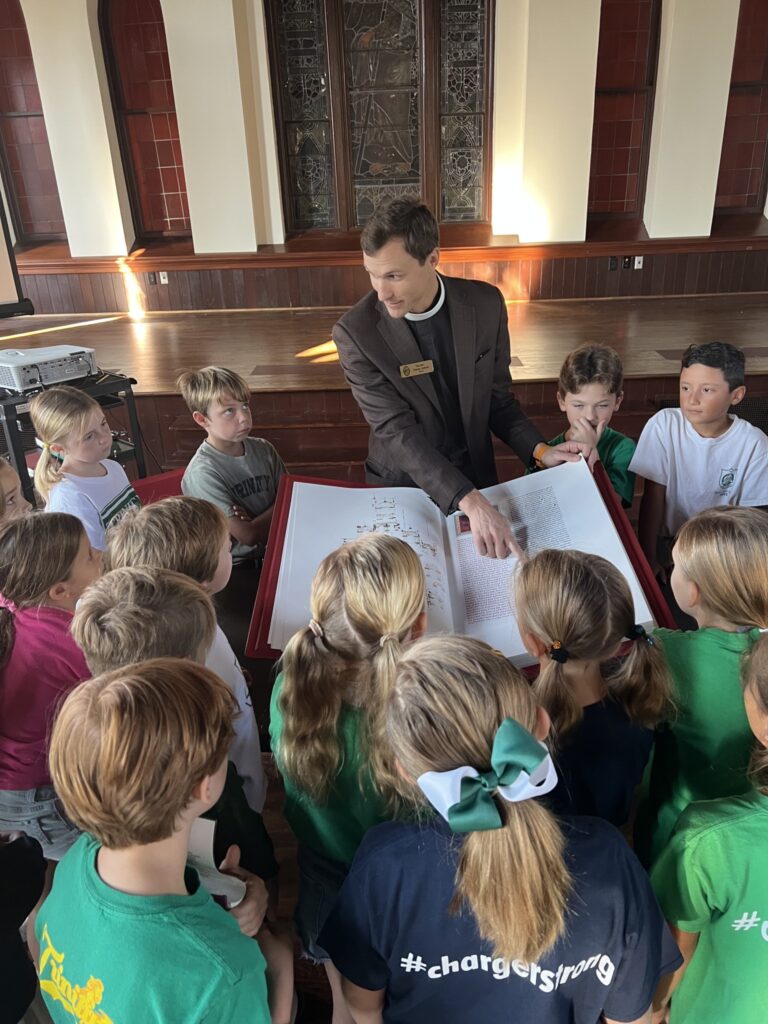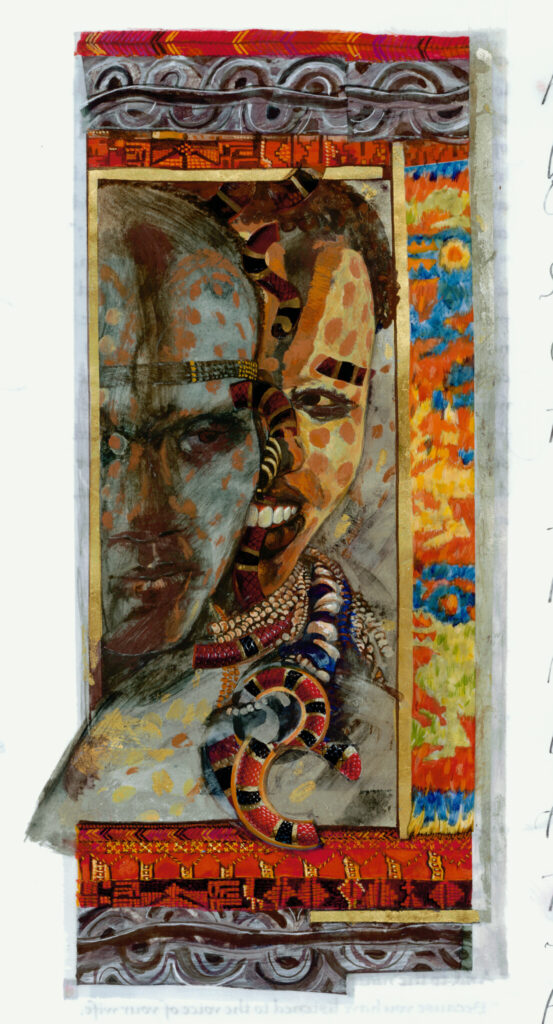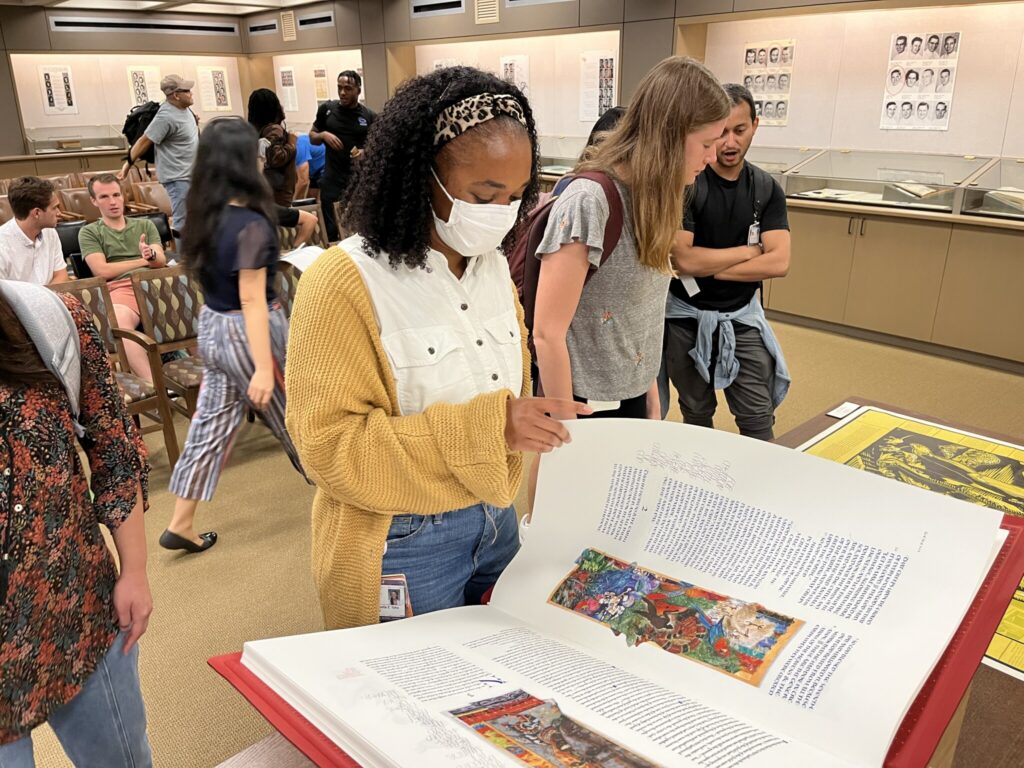Trinity Episcopal Church in Galveston, Texas, is home to many artistic treasures. Listed on the National Register of Historic Places, its Tiffany stained-glass windows are a testament to its renown. Among the treasures are the seven volumes of the Heritage Edition of The Saint John’s Bible, which the congregation received as a gift from local donors.
“At Trinity, we are stewards of many things both beautiful and beyond ourselves,” offered the Reverend Jimmy Abbott.
A Bible for the Community
Since its arrival at Trinity, The Saint John’s Bible has become a key part of the church’s outreach programming. “The Bible seems unapproachable for some, so it’s been great to see more people get comfortable with the Heritage Edition. It’s meant for experiencing, for pondering,” said the Rev. Abbott.

Following an uncrating ceremony to give its congregation the first look at the newly-acquired Heritage Edition, Trinity opened its doors for the greater Galveston community to experience The Saint John’s Bible. Both events proved successful and inspired 20 parishioners to be trained as docents.
Trinity continues its open-door approach with a program for parishioners and community members to explore the Bible during the week. Participants can come to the church, choose any one of the seven volumes, and Trinity staff will set up a reading room so that they may spend as much time as they wish with the Bible. In addition, every Sunday a new set of passages from a volume is available for the congregation to ponder before and after services.
As a church set within a vibrant artistic community, Trinity plans to incorporate the Bible into Galveston’s regular “Art Walks.” With one of the world’s largest quill pen shops just around the corner, Trinity feels it is only appropriate that the Bible’s calligraphy and stunning illuminations are available to local artists and calligraphers.
Illuminations Inform New Perspectives

Trinity is also opening doors to new perspectives in Galveston through the Bible. The Rev. Abbott hosted a seminar for University of Texas Medical Branch students alongside Dr. Michael Malloy[1] , a distinguished educator and clinician. The seminar focused on the interactions between the University’s physicians-in-training and their future patients. “We wanted to stress the need to be aware of other cultures and religious practices,” said Dr. Malloy, “especially during the delicate dance of counseling patients about options they may have for palliative care.”
Dr. Malloy felt that showing The Bible’s Adam and Eve illumination would provide an additional perspective on the medical humanities they’d been studying. Students were already familiar with another depiction of Adam and Eve, UTMB alum Dr. Eric Avery’s Paradise Lost, in which the pair are afflicted by the fourteen major infections of the modern Industrial Age.
While Avery’s piece inspires reflection on how humankind has impacted the environment, The Saint John’s Bible’s illumination invites students to further consider the diverse world they will soon be stepping into. This illumination interprets Adam and Eve as an African man and woman; surrounded by patterns and details of various ancient cultures, the Bible links the first man and woman to the cradle of humankind. This imagery prompted students to consider how far humanity has come since.
The students expressed appreciation for the Bible’s contemporary take on Adam and Eve, as well as the importance of not projecting prejudices when providing care for various populations. This seminar was well received as the students expressed interest in continuing to investigate life perspectives that patients may carry with them, whether influenced by religion, culture, or other factors.
From Medical Students to Middle Schoolers
The Saint John’s Bible illuminations are also making an impact among younger students in Galveston. Following class visits to listen to the Rev. Abbott walk through the Bible, Laurie Boeh, a sixth- and seventh-grade teacher at Trinity Episcopal School, often incorporates the illuminations into her middle school Bible classes.

Laurie uses the illuminations of the Bible to enhance her students’ understandings of what they are reading. “My students were amazed at how one piece of art could symbolize so much, tell so many stories,” Laurie said. “And because this is an enrichment class, that’s exactly what I needed to get them talking.”
Using the illumination Ruth and Naomi, where both women are facing away from the viewer, Laurie encouraged students to share which they thought was Ruth, and which was Naomi. The students relied on the nuances in the story they had read to decide and then shared with one another. Laurie recalled no two reasonings were the same, but that was what she had hoped to see.
“The Saint John’s Bible has given the students a way to really think about how literature, especially the Bible, can be interpreted differently. We all take away different things when we read, and it’s letting them understand that there is no one right answer,” Laurie shared. “It’s added a new and delightful dimension to my teaching.”
At Home in Galveston
As the Bible settles into its home at Trinity Episcopal, it looks to continue expanding its outreach into the broader Galveston community, “We see it as a shared resource for the whole community. It’s ours, yes, but it’s something for all of us,” explained the Rev. Abbott.
